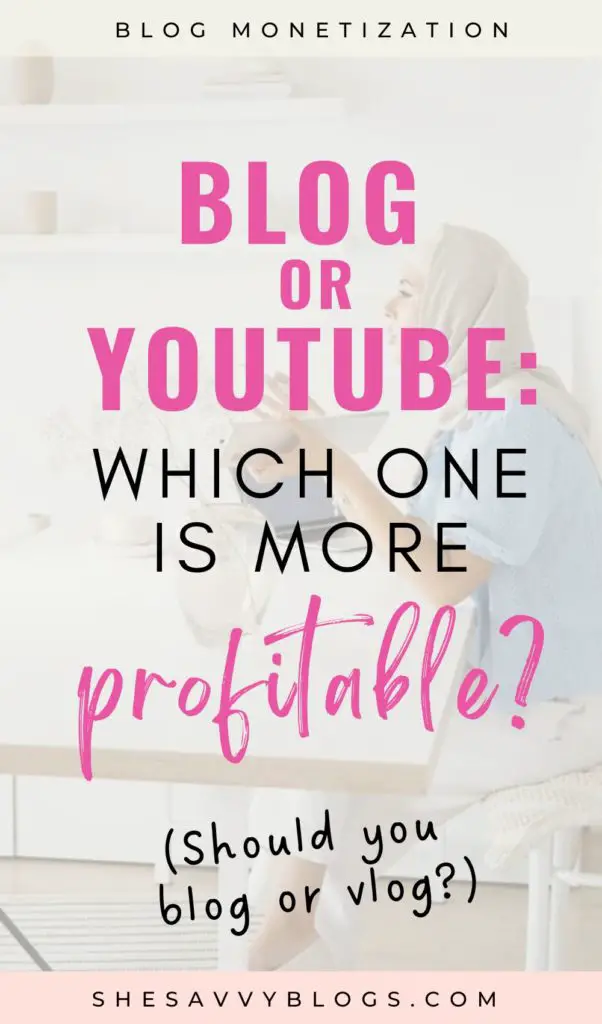*This post may contain affiliate links. That means I may earn a small commission from qualifying purchases or sign-ups at certainly no additional cost to you! Thanks!*
Thanks to the constantly progressing technology, even the most ordinary people, a homebody like me, can build and manage passive income streams.
I’m now a full-time writer — my own boss and my own nagger.
What do I do? I blog and create videos.
The blogging and vlogging industry has been around for years. From what I experienced so far, anyone can earn from it so long as they follow a sustainable strategy.
I know you’re too familiar with blogs and vlogs already. Now your real question is, which one should you start?
Is blogging more profitable than YouTube? Here’s a short overview:
With display ads, blogs earn a range of $10-$25 per 1000 pageviews while YouTubers earn an average of $3.5 per 1000 ad views. However, bloggers and YouTubers also earn through sponsorships, affiliate links, and selling products so earnings vary greatly.
There are more factors to consider which we’ll discuss further.

Blogging VS. Vlogging
Blogging is crafting written-form content published on the internet that helps, informs, or entertains readers.
Back in the day, people blogged as a form of self-expression.
But now, a personal blog or journal rarely gets reads. Instead, people use search engines like Google for immediate answers to queries, how-tos, and research.
Blogging has progressed from a diary-like piece to informative and research-backed blog posts. In blogging, you must provide value.
On the other hand, vlogs or “video blogs” are the video counterpart of written-form content. Most content creators publish their videos on the leading website — YouTube.
You can also upload and earn from videos on Facebook, Patreon, Vimeo, or Twitch. But we know how YouTube is still people’s go-to because the audience is already there.
With Youtube’s current algorithm, even newly published videos from creators have tendencies to reach millions of views in just a week.
How Do Bloggers and Youtubers Make Money?
You may wonder, how do bloggers and YouTubers make money when viewers don’t pay for the content they consume?
There are several profitable ways to do it. Once you publish a blog or video, you must open your channel or website to monetization models.
Publishing on the Internet will get you views.
However, you won’t earn a dime if you don’t get your website or channel properly monetized, nor do you apply to ad networks or open them to business models.
Monetization models for both Bloggers and Youtubers
Blog or YouTube: Which has better monetization?
Content may be presented in different forms — written and video — but they use pretty similar monetization models. Here’s how you monetize your blog and vlog:
- display ads
- affiliate links
- sponsored posts
- paid tools
- selling info-products (e-books, online courses, walkthroughs)
- selling physical products through E-commerce.
- services (ex. freelance work or 1:1 coaching)
1. Display Ads
- Blogging
Yep, content creators earn mostly from advertisers.
Whether you’re managing a blog or a YouTube channel, display ads are the easiest way to make money.
Most bloggers start with Google AdSense.
In my opinion, Google AdSense has a stricter (yet vague) standard before bloggers get approved. For example, you must adhere to the Google AdSense community guidelines.
Your website must have quality content, attractive-looking pages, easy navigation, and of course, a considerable amount of audience.
Here’s my experience in Google AdSense Application — what I did and my website’s status when I got approved.
However, if you’re up for blogging, I have better and way more profitable alternatives for you to monetize through display ads.
Here are the “Big Three” ad networks to choose from:
| Ad Network | Earnings Per 1000 Visits | Minimum Eligibility Criteria |
| Ezoic | $10-$15 |
Join Ezoic here. |
| Mediavine | $22-$25 |
|
| AdThrive |
$22-$25 |
|
With Ezoic, one of my websites, a small passion blog, earned $300 passively in May 2022. That’s already a good ad revenue for a website that I haven’t updated for a while.
- YouTube/vlogging
YouTubers mainly earn from ads. You can see how YouTube turned into a commercial-packed platform with every video, right?
However, unlike in blogging, YouTube partners with Google AdSense so there are no ad network alternatives you can apply for.
YouTubers earn anywhere from $0.001 to $0.007 per ad view depending on the niche. On average, that makes it $0.0035 per ad view or $3.5 per 1000 views.
It varies greatly on your niche, audience, and viewer retention.
YouTube’s requirement for monetization eligibility is as clear as day, compared to the blog requirements.
Your YouTube channel must have at least 1000 subscribers with 4000 hours of watch time, with no Google AdSense violations, to get monetized.
2. Affiliate Income
- Bloggers
Affiliate marketing is simply promoting other people’s products and getting a commission from it,
To bloggers, product-focused blog posts, crafted with affiliate links, can earn them a 3-20% commission per sale, lead, or sign-ups. It can be a one-time payment or a recurring commission.
Here are affiliate programs that accept new bloggers even with low low-traffic websites:
- Amazon Affiliate Program
- JVzoo
- ShareASale
- ClickBank
Want to start affiliate marketing? Here’s how to promote affiliate links effectively on your blog.
- YouTube/vlogging
Commission rates go the same with YouTubers. It only differs in the affiliate program, terms, and conditions.
Have you ever heard a content creator say, “I’ll link to the description below”?
Unlike bloggers who link affiliate products anywhere in their posts, a vlogger only has the description box to add their links which they usually mention and promote in the video.
There are two challenges with vloggers using affiliate sources of income:
First, some affiliate networks require your channel to have 1000 subscribers before agreeing with an affiliate partnership.
But just like blogging, you can also apply to the affiliate networks listed above for new budding channels.
Second, there’s a lower probability of viewers bothering to click on the link on the description compared to a blog. That’s why you have to proactively mention your affiliate links on your vlog or else the viewers will overlook them.
3. Sponsored Posts
- Blogging
If your articles address a specific niche and catch a brand’s eye, these companies would reach out for sponsorship.
They would ask you to write reviews, craft an article with their products on it, or simply publish their pre-written content on your blog in return for a commission or one-time payment.
Sponsored posts can be anywhere from $200 to $10,000 depending on how large your audience is, your page views per month, the size of the email list, and followers on social media where you’d promote the content.
- YouTube/vloggers
Ever watched your favorite content creator plugging a product? Sometimes, they do commercial-heavy clips, others just mention them, but some creators can get more creative.
Yep, that’s a way Youtubers earn — by making sponsored videos.
Sponsored videos are highly negotiable, where YouTubers can ask for a one-time payment between $200 to $10,000 depending on the number of subscribers, views, or size of the email list.
Other sponsors pay through CPV (Cost Per View), which amounts to $0.035 to $0.15 per view.
4. E-Commerce (Physical and Info-products)
Both bloggers and YouTubers can set up an E-Commerce store. They can sell physical products like T-shirts, merchandise, books, or digital products like e-books, printable wall art, etc.
But what’s the difference between selling products on blogs and YouTube?
Bloggers can easily use plugins like WooCommerce and Shopify within their website for easy scrolling and checkouts.
Meanwhile, vloggers need to redirect their viewers to another platform to ensure they’re accommodated. They could add links on their box description box and link out to another website, form, or online shop.
5. Selling Online Courses
In blogging, selling an online course is another excellent way to monetize your blog.
Online courses could range anywhere from $12.99 to $300 (or even higher).
If you’re running a blog, you need to use plugins to create popups, use an attractive thumbnail and display your course on the sidebar, or promote them within your article.
Conversely, YouTubers promote their online courses by mentioning them in the vlog.
But if we’re to compare it, YouTubers have more selling power due to the exposure and engagement. Because the viewers see a real person promoting the course, it looks more authentic to their followers.
I’d say vlogs promote online courses better than blogs.
Should You Blog or Vlog? More Factors to Consider
Although blogging and YouTube are both profitable platforms, there are more factors to consider to guarantee success.
1. Equipment and Expenses
- Blogging
A blogger typically needs a laptop and a stable connection to run a blog. Bloggers could make so much with just the comforts of their homes.
More than the equipment, here are the expenses you can take note of:
| Tools/Services | What I recommend/use | Amount |
|
Bluehost | Starts at $2.95/month, paid annually (comes with 1-year free domain) |
|
Namecheap | Starts at $5.98 |
|
Grammarly | $15/month (has a free version) |
Ready to start a blog? Here are 12 essential tools (both free and paid) I use and recommend to kickstart my blogs.
- YouTubers/ Vlogging
On the other hand, YouTubers need more equipment to make outstanding and engaging videos.
| Tools/Services for Vlogging | What I recommend/use | |
|
Fujiful X-S10 | |
|
Ulanzi Camera Tripod | |
|
Apple MacBook Pro | |
|
Neewer Ring light | |
|
Filmora or Capcut |
|
|
Blue Yeti microphone |
Verdict: Blogging costs are way lower than video making (obviously).
2. Time Required
A 2021 research claims that a blogger requires an average of 3 hours and 42 minutes to write and publish a blog on their website.
The process includes topic research, keyword research, SEO analysis, content structuring, editing images, and content writing.
But to be honest, as someone who takes content writing by heart, it takes me about 4-6 hours (or days!) to write a 1500-word blog post.
Not every blogger is like me, but I prioritize depth, and each piece of content I write must resonate with the reader and me.
If you’re a slow writer (like me), it’s nothing to worry about. Quality is better than quantity. With the constant Google core updates, blogs with no quality lose the competition.
On the other hand, it takes at least two days to make and publish a video on YouTube. Others pre-plan their content and spend a day doing batch videos.
Video-making preparation includes a camera, lights, and audio setup. However, each video also involves topic research and scriptwriting before shooting the entire content.
But from my experience, I can edit mine within a day because the scripts I use are mostly from my blogs, too,
Verdict: Between blogging and YouTube, the planning, execution, and publishing differ on the level of expertise. But if you’re a one-man-band, then YouTube takes a longer time to create.
3. Confidence
Although blogging doesn’t reveal much about the author’s identity, we could still struggle with confidence.
“Do I sound believable? Am I writing nonsense? Did I deliver the message right?” I always feared these back then.
Since the first website I created was an introvert blog, I was scared I’d reveal too much of myself to my friends and family.
For years, I tell them I’m a writer but never sent them a link to my blog.
It’s ironic how I published blogs and articles for the world but melt away when a friend or my family discovers them. That’s one obstacle we need to face.
Moreover, bloggers gain more confidence as they learn the leeways of blogging.
A blogger who not only writes but also understands keyword research, SEO, content structuring, interlinking, and promotions tends to earn revenues and be more successful in blogging.
On the other hand, YouTubers need a whole lot more confidence.
It is not everyone’s cup of tea to speak to a camera; remember lines, talk as if conversing with someone, and bring emotions in their speech.
And it’s one hella challenge new YouTubers have to face.
Compared to Google, YouTube’s algorithm provides content creators more visibility to reach more audiences.
Remember when Youtube recommends random videos to us? Everybody gets a chance to see you. That means more exposure.
Although getting more audience to your videos is incredible, it also means attracting more comments (both good and rude ones), more opinions, and more queries from viewers.
It will be a rollercoaster ride for burnout and anxiety if you haven’t mustered up the right mindset and some steel courage.
Verdict: Based on engagement and reaching out to followers, YouTube wins over blogging.
However, YouTube requires more courage to show your face and let your followers learn more about you. If you have no issues with that, then what can stop you?
Income Reports
Regarding income reports, bloggers and YouTubers may take different routes and use varying monetization models.
Here are tables to show Youtube vs blogging earnings from popular and successful creators,
Let’s look at the monthly income report of three successful bloggers.
| Blog Name | Earnings (per month) | Monetization models |
| The Savvy couple | $43,547 (250,000 pageviews) | Ads, affiliates, Sponsorships, Products |
| Club Thrifty | $86,132 ( 500,000 pageviews) | Ads, affiliates, Sponsorships, Courses, Freelance Writing |
| Dollarsprout | $173,837 (2,431,917 pageviews) | Ads, affiliates, online courses. |
Now let us look at the monthly income report of three successful YouTubers.
| YouTube Channel | Subscribers | Earnings (per month) |
| Mr. Beast | 97.2 million | $450,000 |
| Jake Paul | 20.4 million | $375,000 |
| Markiplier ( Mark Fischbach) | 33 million | $316,600 |
What is better: A blog or a YouTube channel? Who Wins?
Now, we’re here to let you decide on the question “Should I blog or vlog?”
Truth is, there’s no one recipe for which platform serves you more income (and success). It all depends on :
- Content Quality. (Will readers/viewers be hooked with your content?)
- Monetization models used. (How proactive are you in opening your site for monetization?)
- Time and consistency. (It’s not easy to create content. Those who think it’s easy probably didn’t spend much time creating quality. So, are you consistently up for the journey?
- Expenses. (Blogging surely wins when it comes to fewer expenses. But it also boils down to your interest and skill. Are you more of a writer or a speaker?)
- Confidence. (Ready to show your face out there? Then thrive on YouTube.)
But what would I advise you to do?
I say, start where you’re good at and don’t limit your options. I’m first a writer, then converted my blogs into video format to reach a new set of audiences.
On the other hand, some YouTubers use videos primarily and started to take over blogging the following year.
Take note that some topics are better covered on YouTube, and some are in a written article.
When you learn how to manage these two platforms, you’ll realize that it’s more complementary rather than competition.
Whether you choose to blog or vlog at first, having both is absolutely wholesome, business-wise!
You may also like:
- How to Monetize a Lifestyle Blog (And How to Succeed With It)
- 9 Reasons Why Most Bloggers Fail (And What to Do About It)
- 5 Ways to Monetize a Blog Without Google AdSense

